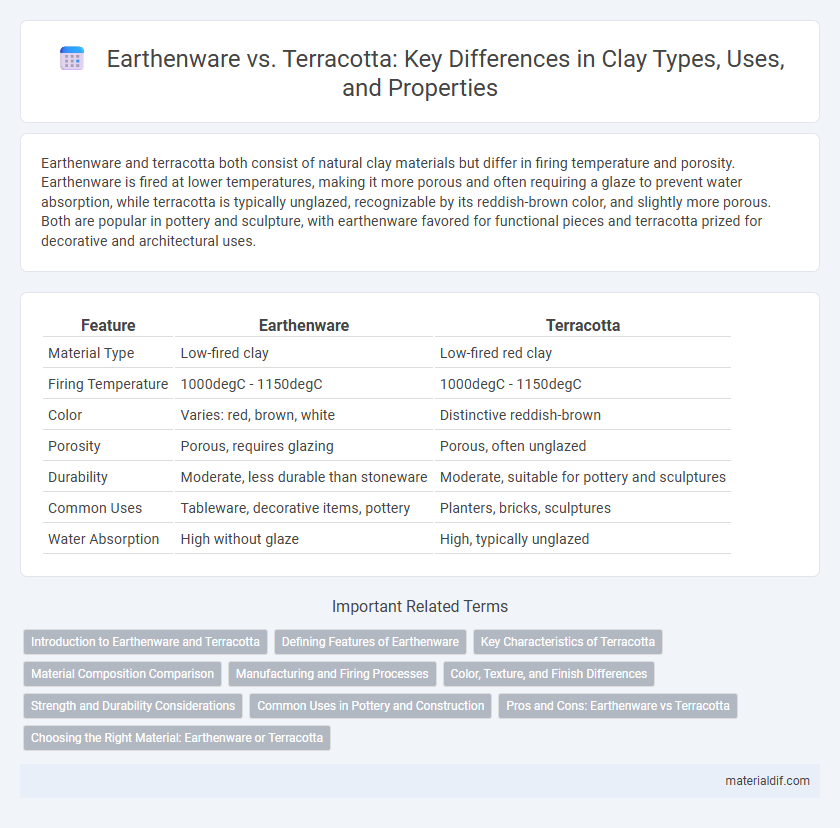Earthenware and terracotta both consist of natural clay materials but differ in firing temperature and porosity. Earthenware is fired at lower temperatures, making it more porous and often requiring a glaze to prevent water absorption, while terracotta is typically unglazed, recognizable by its reddish-brown color, and slightly more porous. Both are popular in pottery and sculpture, with earthenware favored for functional pieces and terracotta prized for decorative and architectural uses.
Table of Comparison
| Feature | Earthenware | Terracotta |
|---|---|---|
| Material Type | Low-fired clay | Low-fired red clay |
| Firing Temperature | 1000degC - 1150degC | 1000degC - 1150degC |
| Color | Varies: red, brown, white | Distinctive reddish-brown |
| Porosity | Porous, requires glazing | Porous, often unglazed |
| Durability | Moderate, less durable than stoneware | Moderate, suitable for pottery and sculptures |
| Common Uses | Tableware, decorative items, pottery | Planters, bricks, sculptures |
| Water Absorption | High without glaze | High, typically unglazed |
Introduction to Earthenware and Terracotta
Earthenware and terracotta are types of porous clay ceramics fired at relatively low temperatures, typically between 1,000degC and 1,150degC. Earthenware is often glazed to become waterproof, making it suitable for pottery and functional vessels, while terracotta retains its natural reddish-brown color due to iron oxide content and is commonly used for sculpture and architectural elements. Both materials have a long history dating back to ancient civilizations, prized for their workability and rustic aesthetic.
Defining Features of Earthenware
Earthenware is a type of ceramic clay known for its porous and coarse texture, typically fired at lower temperatures between 1,000degC and 1,150degC. It is often characterized by its relatively soft body, which is more absorbent compared to stoneware or porcelain, making it ideal for decorative pottery and rustic tableware. The natural reddish or buff color of earthenware results from iron content in the clay, distinguishing it from the denser, more vitrified terracotta.
Key Characteristics of Terracotta
Terracotta is a porous, reddish-brown clay-based ceramic known for its durability and natural, earthy aesthetic, commonly used in pottery, sculpture, and building materials. Its key characteristics include excellent thermal insulation, moderate strength, and the ability to be easily molded and fired at relatively low temperatures compared to other ceramics. The material's susceptibility to water absorption requires sealing for outdoor use, distinguishing it from glazed earthenware which offers a more waterproof surface.
Material Composition Comparison
Earthenware is typically made from a mixture of natural clays, including iron-rich clays that give it a wide color range, while terracotta predominantly consists of iron oxide-rich clay that imparts a distinct reddish-brown hue. The firing temperature for earthenware generally ranges between 1,000degC and 1,150degC, resulting in a porous and less dense material compared to terracotta, which is fired at slightly higher temperatures to enhance durability. Both materials have different mineral compositions that influence their porosity, strength, and suitability for various artistic and functional applications.
Manufacturing and Firing Processes
Earthenware is manufactured using refined clay that is fired at lower temperatures, typically between 1,000degC and 1,150degC, resulting in a porous and less durable ceramic. Terracotta, composed of coarser clay with natural impurities, is fired at slightly higher temperatures, around 1,100degC to 1,200degC, which enhances its strength and makes it suitable for structural applications. The firing process of terracotta often includes oxidation, giving it the characteristic reddish-brown color, whereas earthenware may be glazed to improve its impermeability.
Color, Texture, and Finish Differences
Earthenware typically exhibits a lighter color palette, ranging from cream to reddish tones, while terracotta is characterized by its distinct rich, reddish-brown hue due to higher iron content. The texture of earthenware is smoother and finer, offering a more refined surface compared to terracotta's coarser, porous texture. Finishes on earthenware often include a glossy glaze, enhancing water resistance and visual appeal, whereas terracotta commonly has a matte, unglazed finish that emphasizes its natural, rustic aesthetic.
Strength and Durability Considerations
Earthenware exhibits lower strength and durability compared to terracotta due to its higher porosity and lower firing temperature. Terracotta, fired at higher temperatures, offers enhanced structural integrity and resistance to weathering, making it suitable for outdoor use and heavy-duty applications. When selecting between the two, consider terracotta for projects requiring superior durability and earthenware for decorative purposes.
Common Uses in Pottery and Construction
Earthenware is widely used in pottery for creating decorative items, plant pots, and tableware due to its porous nature and ease of shaping. Terracotta, a subtype of earthenware with a distinctive reddish-brown color from iron content, is commonly employed in construction for roofing tiles, bricks, and sculptures because of its durability and weather resistance. Both materials are favored for their affordability and workability, but terracotta's strength makes it more suitable for structural applications.
Pros and Cons: Earthenware vs Terracotta
Earthenware offers versatility with its porous nature, making it excellent for decorative pottery but less ideal for holding liquids without glazing. Terracotta features higher durability and a distinctive reddish color due to iron content, enhancing its appeal in garden pots and sculptures but it is more prone to chipping. Both materials require careful glazing to improve water resistance, with terracotta generally providing better thermal insulation for plant roots compared to earthenware.
Choosing the Right Material: Earthenware or Terracotta
Earthenware and terracotta, both porous clay materials, differ primarily in firing temperature and durability, with earthenware typically fired at lower temperatures around 1,000degC to 1,150degC and terracotta at slightly higher temperatures near 1,000degC to 1,150degC but often containing more iron oxide. When choosing between them, consider earthenware for decorative, glazed applications due to its softer, more absorbent nature, while terracotta suits functional, rustic pottery and garden ware because of its robustness and characteristic reddish-brown color. Understanding each material's porosity, strength, and aesthetic properties ensures selecting the right clay type for specific ceramic projects or practical uses.
Earthenware vs Terracotta Infographic

 materialdif.com
materialdif.com